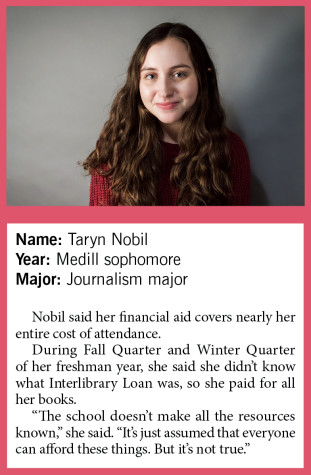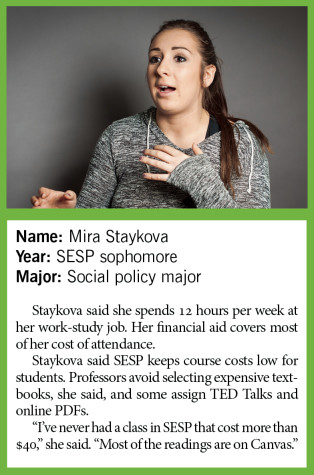In Focus: As University recruits more low-income students, textbook costs still a barrier
November 18, 2015
Lindsey Pape was eyeing a second major.
Pape, then a freshman studying Radio, Television and Film, considered expanding her studies with environmental science: After all, she wants to make documentaries about the environment.
But then she started adding up the costs of General Chemistry and Math 220, the first two classes in the environmental science sequence: the textbooks, the online program subscriptions, a clicker for class. The total climbed above $300. She decided against it.
Pape, who receives financial aid and is work-study eligible, said she didn’t feel comfortable asking her parents to pay that much money so she could explore a new field.
“I had no idea what I should do about it,” the Communication sophomore said. “It just seemed like, ‘Well, I can’t afford the books, so I can’t afford the major.’”
Abby Issarraras, whose financial aid covers nearly all her cost of attendance, said she walked into Blick Art Materials and learned the supplies pack for her art class would cost more than $100. She’d need to pay for the supplies out of pocket, and if she did, she wouldn’t have the money to fly home for Thanksgiving.
Forced to choose between seeing her family and exploring an interest, she chose the former and dropped Introduction to Painting.
“I can’t afford to take a class just for fun,” the Communication junior said. “Isn’t that college? Doing things just for fun?”
Expensive textbooks and supplies can alarm students, prompting some to forgo a class or a major if the price is too high. But costs are often beyond the University’s control: The textbook market sets the price for books, and low-cost digital alternatives aren’t always available.
The issue of textbook accessibility is primed to intensify as Northwestern aims for 20 percent of freshmen in fall 2020 to be Pell Grant recipients, the “20 by 2020” initiative. With that shift already underway, and with a new office supporting low-income students looking to expand, faculty and administrators are working to make textbooks and other course materials more attainable.
“It’s so important for these students to have the same educational opportunities as everyone else,” said Amanda Walsh, president of NU’s chapter of the Quest Scholars Network. “If at the end of the day, you bring these students to campus and you do not allow them to access these opportunities, you are not following up on the promise you made as an institution.”
Barriers to entry
Her junior year, Walsh said she dropped an introductory statistics class because paying about $200 for the textbook would have required her to make sacrifices elsewhere in her life.
 Walsh, a Communication senior, is searching for a job and said she wished she took more math classes at NU.
Walsh, a Communication senior, is searching for a job and said she wished she took more math classes at NU.
“I’m disqualified from so many things because I didn’t take those classes,” she said. “And that’s because textbooks were not accessible to me.”
Students by and large must pay textbook and supply costs out-of-pocket. In theory, students who can’t afford class materials can use money from a work-study job to cover those costs. But Walsh said students often need to use work-study pay to cover some living expenses as well.
“If you have a limited income, you do have to make choices,” she said. “Do I want to pay for a lab coat? Or do I want to pay for electricity in my apartment?”
Even if almost the entire cost of attendance is covered by financial aid, Walsh said, that doesn’t mean a student can afford class materials out of pocket.
Students have found ways to deal with the costs. Communication junior Catherine Sobilo serves on the executive board of Quest, an organization that advocates for low-income and first-generation students. She said she leans on the Interlibrary Loan program, which lets students borrow books from other universities’ libraries.
The service is helpful for her social science classes, she said, which rely more on shorter books. However, it’s not as helpful for textbooks, which are less accessible through the loan program.
Walsh noted students find textbooks in other ways, too. They use course reserves, shop online and search the “Free and For Sale” Facebook page, where students sell their used books.
But Walsh said too many students are “choosing not to take classes they should be able to take.”
“Students don’t always know these resources exist,” she said. “It’s the University’s job to let students know — low-income students in particular — that those things are there.”
Paying for class materials can have social costs as well, Issarraras said. Buying expensive textbooks can prevent her from going out to dinner or purchasing tickets for her friends’ shows.
“It kind of makes you feel like a shitty friend,” she said.
‘Out of control’ costs
Few dispute that faculty should choose what supplies are used in their classes.
“If I’m teaching a class, I want to use the best materials, the materials I think are most appropriate for what I’m going to teach,” said economics Prof. Ron Braeutigam, associate provost for undergraduate education. “What you want is that vehicle that will make learning most effective.”
Mary Finn, associate dean for undergraduate academic affairs in the Weinberg College of Arts and Sciences, said most faculty try to keep course costs low.
“But they have to make sure they have what they need to teach the class,” she said. “I don’t think faculty members are selecting texts that are expensive for no good reason.”
Graphic by Benjamin Din/Daily Senior Staffer
The price of textbooks in particular, though, is often out of faculty members’ hands: The textbook market is controlled by a small group of publishers who dictate prices.
Ariel Diaz, CEO of Boundless, a low-cost textbook company, said the industry isn’t serving consumers well.
“We have supercomputers in our pockets,” he said. “The sum of all human knowledge is one Google search away, and yet $200 textbooks are dominating the market.”
He said even though accessing information is cheaper than ever, textbooks remain expensive.
Since 1977, textbook costs have increased at more than three times the rate of inflation, according to an NBC News analysis of Bureau of Labor Statistics data. An oligopoly dominates the industry, with a few major publishers controlling more than 80 percent of the market.
Diaz said the textbook industry resembles the pharmaceutical industry.
“Doctors are assigning prescriptions to patients, and (the doctors) aren’t the one paying,” he said. “The payer is not the decider, and as a result, the price itself continues to rise at an unsustainable rate … and the people bearing the brunt of this are students.”
But industry advocates say books are expensive to produce. A typical biology textbook, for example, requires a team of authors, researchers, editors, peer reviewers and graphic designers to spend around a collective 24,000 hours creating the text, said David Anderson, an executive director at the Association of American Publishers.
Anderson said producing one textbook can cost as much as $3 million.
“They are essential tools for students to learn,” he said. “And when you consider the price of tuition at a place like Northwestern, the price of textbooks is a small fraction.”
In October, Sen. Dick Durbin (D-Ill.) introduced a bill that would create a grant program for universities to establish “open” textbooks, books available under an open license so students and faculty can access the information for free. The bill aims to pressure the traditional textbook industry to develop cheaper alternatives, Durbin said in a statement.
OpenStax College, a nonprofit based out of Rice University, is one of the largest open-source textbook publishers. The textbooks are peer-reviewed and free online, and the nonprofit estimates the 260,000 students using its textbooks this school year will save a combined $25 million, The Washington Post reported.
The textbook industry, Anderson added, is moving toward offering more online and digital options for students, lowering prices in the process.
‘Putting your money where your mouth is’
For students struggling with textbook or supply costs, the Office of Financial Aid can help, said Brian Drabik, the associate director of undergraduate financial aid.
“Any educational cost they are having difficulty with,” he said, “we should be the first stop for them.”
Drabik said his office can offer a student struggling with textbook costs a “cash advance,” a no-interest loan the student repays, usually at the end of the quarter. The office’s full-time financial aid counselors can also help students find ways to manage those costs.
Some low-income students can also cover textbook costs with their “refund,” Drabik said, the leftover funds on a student’s account when the financial aid received exceeds the amount due on their bills. Drabik said refund values vary widely.
But students who qualify for a refund don’t automatically receive it. They must request it each quarter from the Office of Student Accounts. Some students — especially new students — don’t realize they have a refund available and don’t request it, said Kourtney Cockrell, director of Student Enrichment Services.
SES is a centralized office focused on low-income and first-generation students’ needs. In 2012, a group of students approached Patricia Telles-Irvin, vice president for student affairs, and asked her to create an office to support low-income students. Student Affairs launched SES during Fall Quarter 2014.
 The office’s first academic quarters come as the University works toward its “20 by 2020” initiative. Currently, roughly 14 percent of NU students are Pell-eligible, up from 6.5 percent in 2008.
The office’s first academic quarters come as the University works toward its “20 by 2020” initiative. Currently, roughly 14 percent of NU students are Pell-eligible, up from 6.5 percent in 2008.
Cockrell said the initiative will entail increasing the number of Pell-eligible students from about 1,100 to about 1,700.
“It’s exciting to have a truly reflective demographic, but it requires resources, and it’s expensive,” she said. “It’s all about putting your money where your mouth is.”
Cockrell said she acts primarily as a liaison between students and University departments. Due to federal regulations, her office can’t simply give students money, she said, but she can refer them to financial aid officers, professors and other administrators who can help them access class materials.
The office also sponsors a council of faculty and administrators who aim to integrate support for low-income and first-generation students across the university. Cockrell said the council has begun an “audit” of the University’s departments to determine NU’s most expensive classes. She said they hope to have all the data compiled by the end of Spring Quarter.
Cockrell said her office currently only has “one and a half” employees: herself and a part-time administrative assistant. The lack of staffing, Cockrell said, makes it harder for SES to create institutional change.
“I’m spending so much time one-on-one with students,” she said, “which means the strategic coordination, to try to move policy … You can only do so much in one day.”
Cockrell said she submitted SES’ budget proposal for next fall to Telles-Irvin, asking for two additional staffers: an assistant director and a full-time assistant.
Telles-Irvin oversees the Campus Inclusion and Community office, under which SES is housed. She said new offices often start small so administrators can get a sense of students’ needs.
A year in, though, she said it seems the SES office will need to grow to better serve students.
“It’s very clear to me that there’s a need there,” Telles-Irvin said. “It looks like it’s been successful so far, so we’ll be looking in the future to see how we can continue to enhance that office.”
Work in progress
Administrators, faculty and students are working to improve access to textbooks and supplies.
Weinberg senior Riko Ohashi, Associated Student Government’s vice president for academics, said ASG is pushing for a “cost estimate” feature for students when they register for courses on CAESAR.
Currently, course descriptions on CAESAR include a section for course materials, but sometimes information about required textbooks or supplies isn’t provided.
“Students should know and have that information on hand when they register,” she said. “They should know what they’re signing up for. It shouldn’t be an additional layer of stress on the first day of class.”
Ohashi and her committee have worked primarily with the Registrar’s Office on this proposal, but University Registrar Jaci Casazza said she hesitates to support an estimated-cost system.
“Average cost is hard to determine, because what does that mean?” she said. “Is it average cost for new materials or used materials?”
 What’s more likely to happen, she said, is a more detailed materials list within a course’s description on CAESAR. She also said descriptions could include “course-particular” links that lead students to the Norris Bookstore’s listing of required class materials.
What’s more likely to happen, she said, is a more detailed materials list within a course’s description on CAESAR. She also said descriptions could include “course-particular” links that lead students to the Norris Bookstore’s listing of required class materials.
The earliest this change could be in place is February, when students register for Spring 2016 classes. But Casazza said changes are more likely by May for Fall 2016 registration.
In Weinberg, Finn said the college will work with SES to support low-income chemistry students taking the department’s initial sequence. The textbooks and supplies cost students roughly $600 over the three quarters, Finn said.
“We are spending a great deal of time in all of our meetings talking about the ways in which we are welcoming with great excitement more students who are low-income than in the past,” she said. “Faculty members are really excited about that.”
Walsh said the University has “made great strides” in terms of helping low-income students but still has room for improvement.
“Northwestern does work very hard to make sure all students are supported,” she said. “But there still are students who struggle to afford materials, or they don’t know where to go for help. And that’s a problem.”
This story was updated at 8:55 p.m. on Thursday to clarify that the Financial Aid Office and Office of Student Accounts work together to issue financial aid refunds.
Photos by Jacob Swan and Daniel Tian/Daily Senior Staffers
Graphics by Jacob Swan/Daily Senior Staffer
Email: [email protected]
Twitter: @Shane_McKeon

